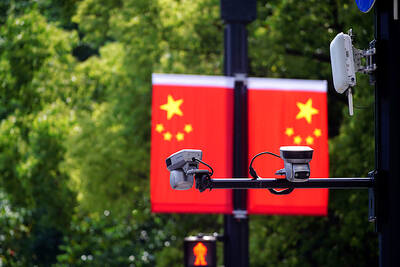Sonkichi Sakihara recalls chancing upon some of the last refugees to arrive on Yonaguni island: four men who had sailed more than 2,000km from Vietnam to reach Japan’s westernmost inhabited island. It was 1977.
“I was out checking for stowaways from Taiwan when I found them,” Sakihara, 80, said at his family store near the port where he encountered the group, among 113 Vietnamese to make the journey after the Vietnam War ended.
Today, some residents of Yonaguni foresee another refugee crisis that they say their isolated outpost and its dwindling population of less than 1,700 would be ill-equipped to handle.

Photo: Reuters
Just 110km to the west, and occasionally visible from Yonaguni, is Taiwan, which China is menacing with simulated missile strikes and other displays of military firepower.
Concerned about the potential for conflict, Japan has embarked on its biggest defense buildup since World War II. Yet the US$290 billion outlay comes without a parallel plan to prepare Yonaguni for a possible humanitarian crisis that residents like Sakihara say could quickly overwhelm their shores.
In interviews with reporters, more than two dozen current and former Japanese officials and residents said that hundreds, if not thousands of refugees could try to reach Yonaguni in boats if China attacked Taiwan.

Photo: Reuters
Tokyo has no plan to deal with them, and locals’ pleas for help have gone unanswered, they said.
“It’s like their mouths are taped shut,” Yonaguni Mayor Kenichi Itokazu said, referring to Japan’s central government.
Itokazu said he had appealed directly to Japanese Chief Cabinet Secretary Hirokazu Matsuno for help when he came to Yonaguni in July, but received no response.
Some US officials say China might be ready to invade Taiwan by 2027. Chinese President Xi Jinping (習近平) told US President Joe Biden last month that no such plan exists, but he is raising pressure on Taiwan ahead of the nation’s Jan. 13 presidential and legislative elections.
In Taipei, the Ministry of Foreign Affairs declined to address questions about whether it had discussed humanitarian contingencies with Japan, but said Taiwan would not act rashly or succumb to Chinese coercion.
A spokesperson for Japan’s Cabinet Secretariat said that “if large numbers of refugees came to Japan, relevant government departments would work together to respond.”
He declined to comment on whether there was a specific plan for Yonaguni, saying he did not know whether the island’s mayor had directly asked Matsuno for help.
CRISIS SCENARIO
The people who spoke to reporters included nine current and six former officials with knowledge of Japan’s emergency planning, some of whom spoke on condition of anonymity due to being unauthorized to comment publicly.
While Taiwanese refugees could flee to Japan by sea, the nature of any conflict and the numbers who would come were hard to predict. Japan’s government has made no public mention of such a scenario, they said.
“There could be hundreds of boats, too many even for a Chinese blockade to stop,” a Japan Coast Guard official said.
The Cabinet Secretariat, headed by Japanese Prime Minister Fumio Kishida and run by Matsuno, is responsible for devising a plan, he added.
The current and former officials described a government focused on its military buildup rather than a complex humanitarian response plan encompassing the multiple departments, local authorities and companies that would have to screen, transport, feed and house possibly more refugees than Japan has ever encountered.
About 18,000 refugees were in Japan last year, mostly from Myanmar, Japan’s Migration Policy Institute said, citing UN figures that apply a broader definition than the Japanese government.
Amid conflict in Europe and the Middle East, Germany had more than 2 million refugees and Poland almost 1 million, many from Ukraine.
Tokyo has a political decision to make on whether to accept significant numbers of refugees, said Washington-based NMV Consulting senior adviser Kevin Maher, who was previously head of Japan affairs at the US Department of State.
“Japan has been reluctant to let in large numbers but, whatever the policy may be, the reality is that just about anything that floats could be headed for Japan,” he said.
A BIG JOB
Japanese General Yoshihide Yoshida, the head of Japan Self-Defense Forces (SDF), said he witnessed the refugee crisis caused by Russia’s attack on Ukraine when he visited Poland last year.
“If something similar happened near us, we would have to offer the same kind of humanitarian response, but that shouldn’t be left to the SDF, it’s for the whole of government to consider thoroughly,” he said on Tokunoshima, an island at the eastern end of the Ryukyu Islands that includes Yonaguni, where he was observing beach landing drills by Japanese forces on Nov. 19.
The roughly 200 SDF troops stationed on Yonaguni could be among the first to respond to any refugee crisis should East Asia, as Kishida warned last year, become the next Ukraine.
However, in more than 100 pages of documents outlining Kishida’s military buildup, refugees are mentioned only once, in a general reference to working with the UN.
Tokyo would hesitate to implement specific humanitarian plans on Yonaguni as it could lead China into believing Japan is preparing for a Taiwan conflict, a US official with knowledge of Japanese thinking said, speaking on condition of anonymity due to being unauthorized to comment publicly.
Even if he had a refugee plan, Kishida would still face an obstacle: his contentious relationship with the Okinawa prefectural government that administers Yonaguni.
The prefecture’s governor, Denny Tamaki, wants fewer US troops based in his prefecture, opposes Kishida’s military expansion and says it is the prime minister’s job to manage migrants arriving by boat.
“Even if it’s left to local government, the authority and financial resources for this have not yet been clearly defined,” he said in an interview.
Resentment with Tokyo lingers in Okinawa over the deaths of one in four islanders in World War II and the substantial military presence that has been there since.
In March, Okinawa and Tokyo officials conducted their first tabletop drill to simulate the evacuation of about 120,000 residents and tourists in Japan’s southwestern islands, including Yonaguni, calculating the operation would take about a week.
“There is no guarantee people won’t come from Taiwan and it would overwhelm the system,” said one of the drill’s advisers, Hironobu Nakabayashi from Kokushikan University’s Research Institute of Disaster Management and Emergency Medical System.
NOT ENOUGH TO SHARE
Back on Yonaguni, resident Satoshi Nagahama, 33, was surprised to learn that the government had no humanitarian plan in place for refugees.
“I don’t think we could handle any. The government would have to take them elsewhere,” he said.
Even the community center that temporarily housed the Vietnamese refugees Sakihara found has been closed for a decade, its crumbling concrete walls draped in green netting.
Without government help, some residents say it would fall to the island’s two police officers or town hall officials, including Koji Sugama, a 65-year-old former soldier, to handle any refugee crisis.
Since being hired in April to improve disaster management, one of Sugama’s tasks has been procuring emergency supplies for residents, including bottled water and ready meals packed into three heavy steel shipping containers dotted around the island.
“This will do for one, maybe two days,” he said, standing inside one of them. “There isn’t enough to share.”

Actor Darren Wang (王大陸) was questioned by prosecutors for allegedly orchestrating an attack on a taxi driver after he was allegedly driven on a longer than necessary route in a car he disliked. The questioning at the New Taipei City District Prosecutors’ Office was ongoing as of press time last night. Police have recommended charges of attempted murder. The legally embattled actor — known for his role in the coming-of-age film Our Times (我的少女時代) — is under a separate investigation for allegedly using fake medical documents to evade mandatory military service. According to local media reports, police said Wang earlier last year ordered a

CAUTION: Based on intelligence from the nation’s security agencies, MOFA has cautioned Taiwanese travelers about heightened safety risks in China-friendly countries The Ministry of Foreign Affairs (MOFA) yesterday urged Taiwanese to be aware of their safety when traveling abroad, especially in countries that are friendly to China. China in June last year issued 22 guidelines that allow its courts to try in absentia and sentence to death so-called “diehard” Taiwanese independence activists, even though Chinese courts have no jurisdiction in Taiwan. Late last month, a senior Chinese official gave closed-door instructions to state security units to implement the guidelines in countries friendly to China, a government memo and a senior Taiwan security official said, based on information gathered by Taiwan’s intelligence agency. The

Taiwan Semiconductor Manufacturing Co (TSMC), the world’s largest contract chipmaker, said yesterday that it is looking to hire 8,000 people this year, at a time when the tech giant is expanding production capacity to maintain its lead over competitors. To attract talent, TSMC would launch a large-scale recruitment campaign on campuses across Taiwan, where a newly recruited engineer with a master’s degree could expect to receive an average salary of NT$2.2 million (US$60,912), which is much higher than the 2023 national average of NT$709,000 for those in the same category, according to government statistics. TSMC, which accounted for more than 60 percent

President William Lai (賴清德) should protect Taiwan Semiconductor Manufacturing Co (TSMC), and stop supporting domestic strife and discord, former president Ma Ying-jeou (馬英九) wrote on Facebook yesterday. US President Donald Trump and TSMC on Monday jointly announced that the company would invest an additional US$100 billion over the next few years to expand its semiconductor manufacturing operations in the US. The TSMC plans have promoted concern in Taiwan that it would effectively lead to the chipmaking giant becoming Americanized. The Lai administration lacks tangible policies to address concerns that Taiwan might follow in Ukraine’s footsteps, Ma wrote. Instead, it seems to think it could